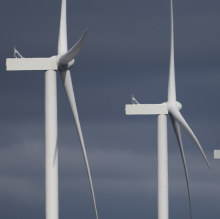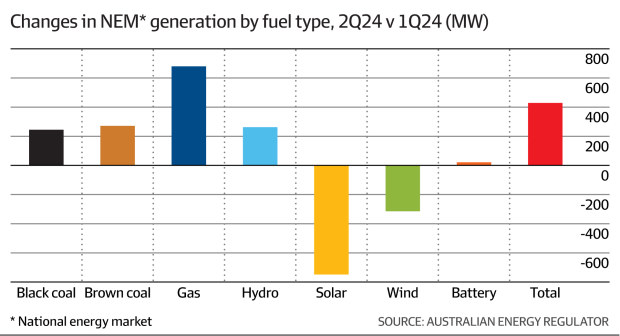From the Fin review
Power prices: Wholesale prices nearly doubled as onset of renewables falls short of winter needsA 70 per cent surge in gas-fuelled power generation was behind a near-doubling of wholesale electricity prices across some south-eastern states in the June quarter, while forward prices for power rose across the board amid worries about potential supply shocks.
The figures from the Australian Energy Regulator confirmed a “drought” in wind power generation in the April-June period, when electricity produced from wind turbines slid to just 12 per cent, its lowest share in the mix since the same quarter in 2021.
Wind farms produced much less electricity in the June quarter than is typical for the period. Martin Ollman.
At the same time, “minimal” new generation was added to the market, with only one wind farm, at Goyder South in South Australia, coming online as Australia’s build-out of clean energy generation to replace coal falls further behind the rate needed to replace ageing coal generators and meet 2030 climate targets.
Solar generation was also subdued, as is normal with the shorter days of autumn and early winter, forcing increased use also of hydropower. Gas power generation was 70 per cent higher than in the March quarter, at 1653 megawatts, and 16 per cent above the same period last year.
The weak renewable power generation triggered a resurgence in coal generation, with black coal power – as produced in NSW and Queensland – up 7 per cent in a quarter that also included a decision to extend the life of the country’s biggest coal generator.
The confluence of factors pushed up wholesale power prices 99 per cent in Victoria compared with the preceding three months, while prices in NSW rocketed 86 per cent to the highest level among the states, of $189/MWh. A drought in Tasmania saw prices soar 110 per cent to similar levels as Victoria. Only Queensland had lower prices than in the March quarter.
“While we would expect to see wholesale prices rise as weather in southern states cools and demand rises to keep people warm, the combined impact of cold snaps, planned and unforeseen network outages, combined with rebidding and lower solar and wind output has pushed electricity prices higher than this time last year,” AER board member Jarrod Ball said.
The Australian Energy Market Operator calculated that, on average, wholesale prices across the National Electricity Market jumped 23 per cent from a year earlier, to $133/MWh.
A spokeswoman for Energy Minister Chris Bowen said the data showed renewables provided cheaper power, “and when we’re forced to rely on coal generation and ageing unreliable assets, it drives prices up”.
“The faster we can get more reliable renewables into the system, the better it will be for energy bills and energy reliability,” she said.
In its separate quarterly review, released also on Wednesday, AEMO cited cold weather as the reason behind a new June quarter record for electricity demand. AEMO highlighted the drop in wind and hydropower generation in the quarter and the pick-up in gas and coal power.
“These market conditions highlight the important role that batteries, pumped hydro and flexible gas generation will play as renewable generation becomes more dominant in Australia’s electricity grids,” said AEMO chief executive Daniel Westerman.
The June quarter was also marked by a jump in “high price events” – when the spot market price over 30 minutes tops $5000/MWh – compared to a year earlier, to 19, the AER said. Of those, 15 occurred in NSW across May 7-8, when AEMO was forced to cap prices at $600/MWh after prices soared due to outages at power stations coinciding with maintenance on transmission lines.
The AER said the low level of new generation entering the market would only likely pick up in the second half of 2024 and early 2025. Some 18 new generators are due online this half, although some are already running late.
The increased demand for gas for electricity generation caused AEMO to issue an alert in June about potential shortages emerging on peak demand days before the winter is out. The AER noted the operator has not had to intervene in the market but said that was still a possibility if the risks to supply worsen, just as occurred in 2022.
- Forums
- ASX - By Stock
- AGL
- Ann: Updated FY24 Guidance
AGL
agl energy limited.
Add to My Watchlist
0.05%
 !
$10.51
!
$10.51
Ann: Updated FY24 Guidance, page-55
Featured News
Add to My Watchlist
What is My Watchlist?
A personalised tool to help users track selected stocks. Delivering real-time notifications on price updates, announcements, and performance stats on each to help make informed investment decisions.
 (20min delay) (20min delay)
|
|||||
|
Last
$10.51 |
Change
-0.005(0.05%) |
Mkt cap ! $7.063B | |||
| Open | High | Low | Value | Volume |
| $10.50 | $10.55 | $10.46 | $3.418M | 325.4K |
Buyers (Bids)
| No. | Vol. | Price($) |
|---|---|---|
| 24 | 5284 | $10.50 |
Sellers (Offers)
| Price($) | Vol. | No. |
|---|---|---|
| $10.51 | 4633 | 29 |
View Market Depth
| No. | Vol. | Price($) |
|---|---|---|
| 28 | 3717 | 10.490 |
| 22 | 6648 | 10.480 |
| 22 | 18327 | 10.470 |
| 16 | 7326 | 10.460 |
| 10 | 22054 | 10.450 |
| Price($) | Vol. | No. |
|---|---|---|
| 10.500 | 3638 | 24 |
| 10.510 | 6165 | 23 |
| 10.520 | 6387 | 14 |
| 10.530 | 10771 | 12 |
| 10.540 | 5588 | 9 |
| Last trade - 12.18pm 17/06/2025 (20 minute delay) ? |
Featured News
| AGL (ASX) Chart |
The Watchlist
RC1
REDCASTLE RESOURCES LIMITED
Ronald Miller, Non-Executive Director
Ronald Miller
Non-Executive Director
SPONSORED BY The Market Online






